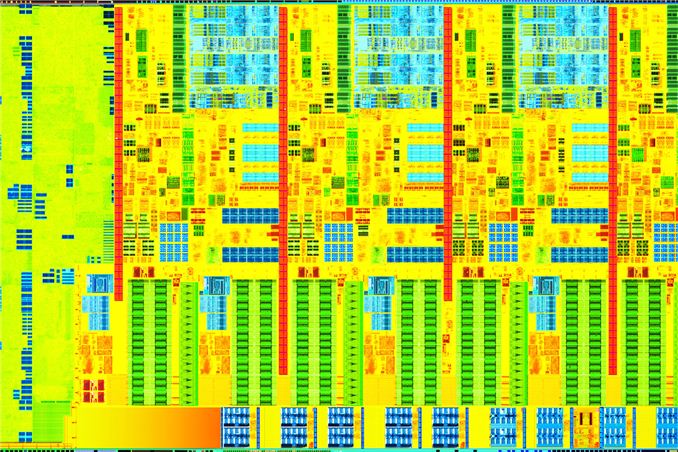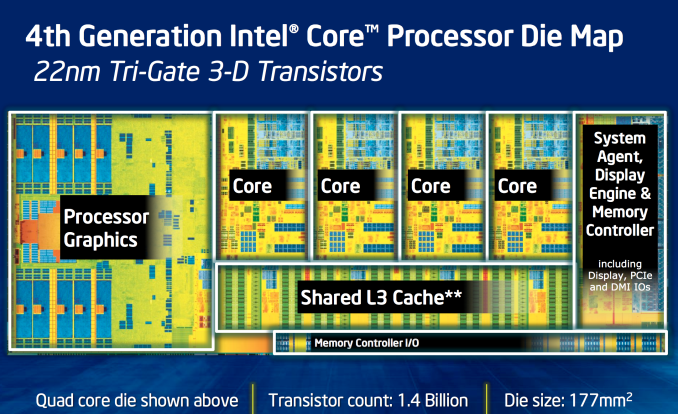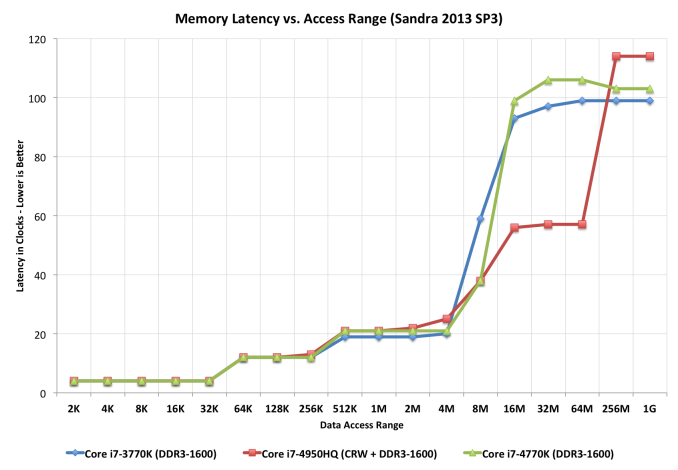The Haswell Review: Intel Core i7-4770K & i5-4670K Tested
by Anand Lal Shimpi on June 1, 2013 10:00 AM EST
This is a very volatile time for Intel. In an ARM-less vacuum, Intel’s Haswell architecture would likely be the most amazing thing to happen to the tech industry in years. In mobile Haswell is slated to bring about the single largest improvement in battery life in Intel history. In graphics, Haswell completely redefines the expectations for processor graphics. There are even some versions that come with an on-package 128MB L4 cache. And on the desktop, Haswell is the epitome of polish and evolution of the Core microprocessor architecture. Everything is better, faster and more efficient.
There’s very little to complain about with Haswell. Sure, the days of insane overclocks without touching voltage knobs are long gone. With any mobile-first, power optimized architecture, any excess frequency at default voltages is viewed as wasted power. So Haswell won’t overclock any better than Ivy Bridge, at least without exotic cooling.
You could also complain that, for a tock, the CPU performance gains aren’t large enough. Intel promised 5 - 15% gains over Ivy Bridge at the same frequencies, and most of my tests agree with that. It’s still forward progress, without substantial increases in power consumption, but it’s not revolutionary. We compare the rest of the industry to Intel’s excellent single threaded performance and generally come away disappointed. The downside to being on the top is that virtually all improvements appear incremental.
The fact of the matter is that the most exciting implementations of Haswell exist outside of the desktop parts. Big gains in battery life, power consumption and even a broadening of the types of form factors the Core family of processors will fit into all apply elsewhere. Over the coming weeks and months we’ll be seeing lots of that, but today, at least in this article, the focus is on the desktop.
Haswell CPU Architecture Recap
Haswell is Intel’s second 22nm microprocessor architecture, a tock in Intel’s nomenclature. I went through a deep dive on Haswell’s Architecture late last year after IDF, but I’ll offer a brief summary here.
At the front end of the pipeline, Haswell improved branch prediction. It’s the execution engine where Intel spent most of its time however. Intel significantly increased the sizes of buffers and datastructures within the CPU core. The out-of-order window grew, to feed an even more parallel set of execution resources.
Intel added two new execution ports (8 vs 6), a first since the introduction of the Core microarchitecture back in 2006.
On the ISA side, Intel added support for AVX2, which includes an FMA operation that considerably increases FP throughput of the machine. With a doubling of peak FP throughput, Intel doubled L1 cache bandwidth to feed the beast. Intel also added support for transactional memory instructions (TSX) on some Haswell SKUs.
The L3 cache is now back on its own power/frequency plane, although most of the time it seems to run in lockstep with the CPU cores. There appears to be a 2 - 3 cycle access penalty as a result of decoupling the L3 cache.


















210 Comments
View All Comments
CajunArson - Saturday, June 1, 2013 - link
Great review, but I have a question about this rather cryptic comment for bclk overclocking:"All CPUs are frequency locked, however K-series parts ship fully unlocked. A new addition is the ability to adjust BCLK to one of three pre-defined straps (100/125/167MHz). The BCLK adjustment gives you a little more flexibility when overclocking, but you still need a K-SKU to take advantage of the options."
Does that mean you cannot do bclk overclocking on the non-K series parts? For example, are you saying that a 4770 (non-K) part cannot be used with a bclk overclock? Or are you just saying that the K-series parts give you all the options including unlocked multipliers? Can you clarify this?
Rajinder Gill - Saturday, June 1, 2013 - link
All you can do on the non K parts is 100 bclk +- 5%.smilingcrow - Saturday, June 1, 2013 - link
It doesn't seem cryptic to me!kasakka - Saturday, June 1, 2013 - link
Too bad there are no temperature comparisons. Would be interesting to see if Intel has improved the TIM under the heatspreader.That said, now I'm glad I didn't wait for Haswell as it doesn't seem to have much to give over Ivy unless you use the intergrated GPU.
A5 - Saturday, June 1, 2013 - link
Other reviews have it as notably hotter under load, fwiw. Probably due to the voltage regulators.HisDivineOrder - Saturday, June 1, 2013 - link
Now that AMD has mostly fallen back to the mid-range and low-end, this is a similar situation to where the new Geforces landed.You get a bit more performance for about the same money. For the GPU side, the benefit was mostly in superior cooling solutions all (supposedly) having to be equivalent to the excellent Titan Blower. For the CPU side, the benefit is that we have lower idles. These chips stay in idle a lot, so it's a gain, but this isn't a chip that's going to light the hobbyist world on fire.
Just like with the GF770, you get more performance and a few fringe benefits (that should have been there all along, ie., 6 SATA3 connections) for the same as you would have paid for the equivalent part last week.
I don't see much here to make me want to upgrade from my IVB 3750k, though. I'm leaning toward picking up a used GF670 and SLI'ing now, given all the givens.
The truly disappointing part of all this is if this is truly the last new desktop release for two years. Imagine me going 3+ years before I even FEEL an itch to upgrade my processor. I sincerely pray that AMD gets its act together and puts some competitive pressure on Intel at the mid-high end (ie., 2500k, 3570k) with a truly great CPU. I live in hope that the 8350 successor (based on Steamroller?) will be that part, but AMD needs to update their chipsets big time.
Until then, I think all we can expect from Intel and nVidia is more of the same, which is the worst part of both the 700 series and Haswell. Neither felt compelled to do more than offer minor improvements in performance because neither is feeling any competitive pressure of any kind.
That's why Intel IS pushing the power argument and fighting that fight hard. Because ARM *is* applying competitive pressure.
Hector2 - Saturday, June 1, 2013 - link
Even without competition, Intel is still by economics to keep pushing transistor sizes and die sizes smaller and smaller --- it still lowers their costs and they make more money. This also means they keep getting faster and require less and less power. What competition does, besides lower prices, is drive architectural changes that add more die size (like an integrated GPU and FIVR)JDG1980 - Saturday, June 1, 2013 - link
Keep in mind that an increasing percentage of desktop/laptop PCs are now in the business world (since light-use consumers have often moved towards tablets and smartphones). If you're doing office work, then lower power use on idle/light load is a big deal. Office PCs almost never run balls-to-the-wall. In fact, usually the only time the CPU even comes close to being completely pegged is when the mandatory virus scan runs (and even then, it's often HDD-bound).leliel - Saturday, June 1, 2013 - link
I'm still on a Lynnfield 750 (as are a few other commenters, I note) and this system is now 3.5 years old without me having had the itch to upgrade or even overclock the CPU. I have been eyeing Haswell because I know I will be making a fresh build at the end of the year, but that's due to circumstance and not need. 30% clock increase in four years is nothing like the old days... but frankly it's nice to be able to keep up in everything just by swapping out video cards.Klimax - Sunday, June 2, 2013 - link
I doubt we will see large increases in future. We need new algorithms. (Current ones are the limit) Why? Because major performance increases would require significant increase in complexity and GPU showed what that causes.And AMD won't and cannot change it.